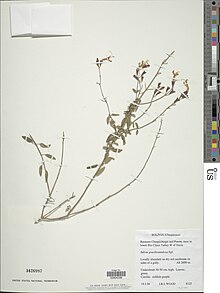Salvia graciliramulosa is a shrub that is endemic to the Rio Chico valley of Bolivia, growing in red sandstone outcrops at 1,600 to 1,900 m (5,200 to 6,200 ft) elevation, often growing in colonies on bare slopes.
| Salvia graciliramulosa | |
|---|---|

| |
| Scientific classification | |
| Kingdom: | Plantae |
| Clade: | Tracheophytes |
| Clade: | Angiosperms |
| Clade: | Eudicots |
| Clade: | Asterids |
| Order: | Lamiales |
| Family: | Lamiaceae |
| Genus: | Salvia |
| Species: | S. graciliramulosa
|
| Binomial name | |
| Salvia graciliramulosa Epling & Játiva
| |
S. graciliramulosa has many branches, reaching 30 to 80 centimetres (0.98 to 2.62 ft) high, with shortly petiolate leaves that are 1 to 2.7 cm (0.39 to 1.06 in) by .3 to .8 cm (0.12 to 0.31 in). The inflorescence of simple terminal spikes grows up to 10 cm (3.9 in) long, with two-flowered verticillasters and a red to reddish-purple corolla that is 1.8 to 2.5 cm (0.71 to 0.98 in) long, held in a deep violet calyx.[1]
Notes
edit